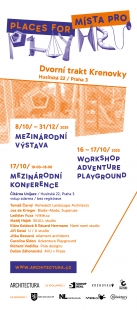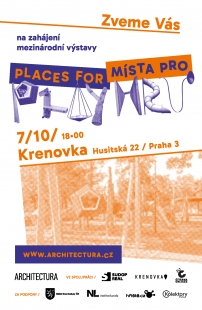
MÍSTA PRO HRU
Pořadatel
ARCHITECTURA z.s., Krenovka
Místo konání
Krenovka, Husitská 22, Praha 3
Start
wed 08.10.2025 00:00
End
wed 31.12.2025 23:00
vernissage
tue 07.10.2025 18:00
Odkaz
https://www ...
ARCHITECTURA z.s., Krenovka
Místo konání
Krenovka, Husitská 22, Praha 3
Start
wed 08.10.2025 00:00
End
wed 31.12.2025 23:00
vernissage
tue 07.10.2025 18:00
Odkaz
https://www ...
Exhibitions
Publisher
ARCHITECTURA z.s.
ARCHITECTURA z.s.
In the last third of the past century, children's playgrounds began to emerge in our country with fun and often even unique features, in which artists and landscape architects also participated (for example, Zdeněk Němeček, Olbram Zoubek, and Eva Kmentová in Prague, Kurt Gebauer in Ostrava, Miroslav Jirava in Krnov, Vladimír Sitta, Tamara Divišková, or Zdeněk Macháček in Brno, Roman Richtermoc and Oldřich Semrád in Hradec Králové). They used to be isolated but often became icons, and many of them have recently been restored, albeit under the new status of artworks rather than play elements. At the end of the 90s, there was a boom of unified and not always creative, but primarily materially or aesthetically uninteresting play elements. This average production triggered a reason to reassess quality production from previous years and also, notably among parents-artists, architects, and landscape architects, a strong desire to transform the situation. A significant part of this is also inspired by successful realizations abroad, often signed by renowned authors and awarded in the context of architectural and urban international exhibitions that focus on the revitalization of public spaces. The phenomenon of Adventure playground (adventure play; the concept of unfinished playgrounds that children build themselves under the supervision of instructors), which originated in Denmark in the 1940s and has represented a common practice in the European environment during the following eighty years, is also becoming known among Czech parents, educators, and community politicians. Additionally, numerous scientific playgrounds, educational-sporting elements in nature, of course skate parks, and spaces for parkour are emerging. Our selection of forty projects, which include contemporary Czech and foreign examples as well as older and still popular realizations, aimed to present the most varied perspective on this topic. Therefore, there are projects that bring successful solutions for the revitalization of former mining areas, power plants, housing estates, abandoned parks, dead space in front of schools, space under bridges, waterfronts, the use of rooftops of parking garages, climbing frames, as well as entire sports, educational, or fairy-tale areas in nature, urban and artistic transformations of parks, squares, or ordinary sports fields. The playgrounds in our selection have become places for the emergence of new community life, the establishment of a small sculpture museum, environments for involving children of various ages in sports, environmental, theatrical, or artistic days. Encountering these projects and their creators has been a great inspiration for us, and we believe that their stories will inspire visitors as well, and that the exhibition will contribute, even in a small way, to positive changes in play spaces.
The English translation is powered by AI tool. Switch to Czech to view the original text source.


0 comments
add comment











